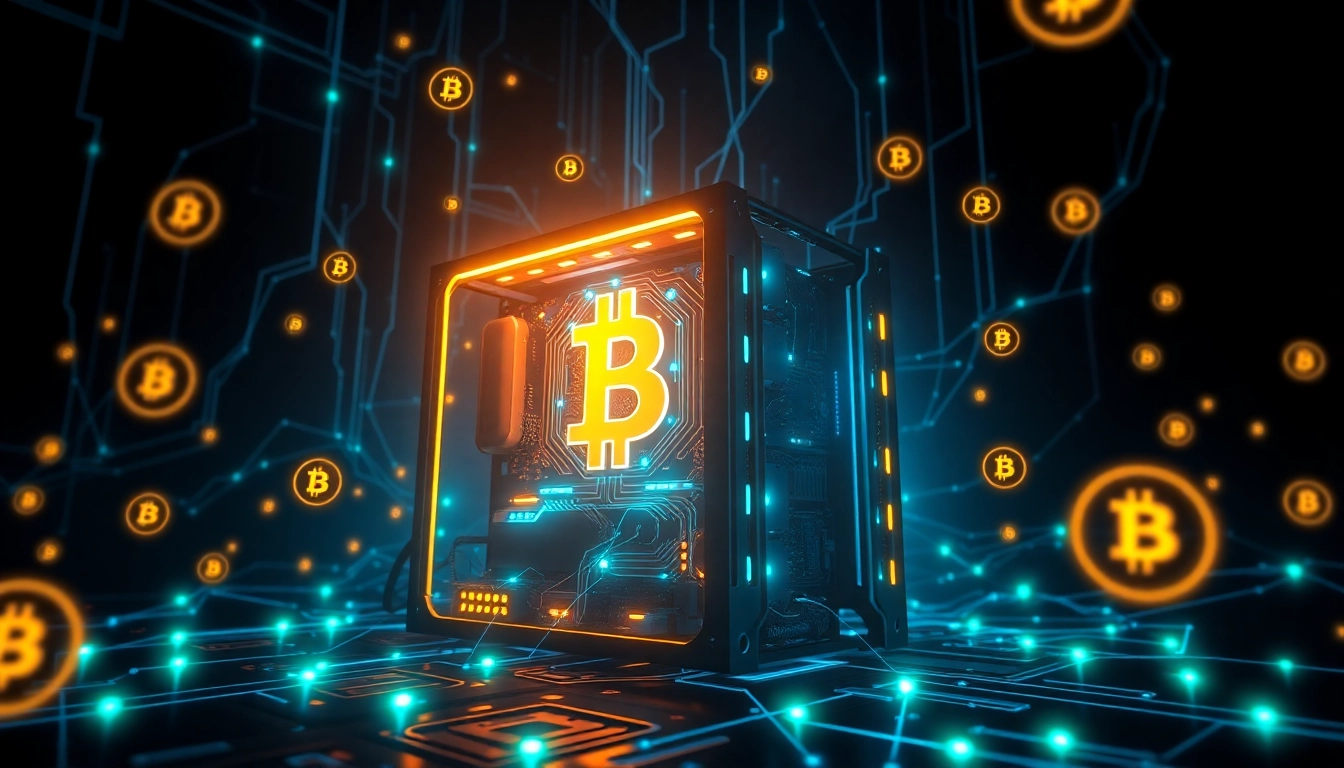Understanding Bitcoin Mining
What is Bitcoin Mining?
Bitcoin mining is a crucial process within the revolutionary blockchain ecosystem. It involves solving complex mathematical problems using computational power, allowing miners to validate and record transactions on the Bitcoin network. This process is not merely about generating new bitcoins but also about maintaining the security and integrity of the network.
In simple terms, Bitcoin mining can be seen as a decentralized lottery—an open competition where miners vie to solve intricate puzzles. The first one to crack the code gets the right to add a block to the blockchain and, in return, earns freshly minted bitcoins along with transaction fees attached to the validated transactions.
Understanding Bitcoin mining is essential for anyone interested in cryptocurrency, as it sits at the very heart of how Bitcoin operates.
The Importance of Bitcoin Mining in the Blockchain
The significance of Bitcoin mining extends beyond merely minting new coins; it plays a vital role in the functionality and security of the Bitcoin network. Each time a miner effectively adds a block to the blockchain, they contribute to the overall health of the blockchain by ensuring that transactions are legitimate and cannot be altered retroactively.
This decentralized validation process is foundational, as it allows users to trust the system without relying on a central authority. Additionally, mining prevents double-spending—a crucial aspect for ensuring the integrity of digital currencies. Every block added to the blockchain is a verified record that is timestamped, making fraudulent alterations nearly impossible.
How Bitcoin Mining Works: A Technical Overview
The technical aspect of Bitcoin mining can be described in several stages:
- Transaction Broadcasting: When a Bitcoin transaction occurs, it is broadcasted to the network, where miners can access it.
- Transaction Verification: Miners validate these transactions, ensuring that the sender has enough balance to complete the transaction and that it has not been previously spent.
- Assembling Blocks: Validated transactions are placed into a block, which contains a cryptographic hash of the previous block along with a nonce (a random number used for generating new hashes).
- Proof of Work: Miners race to compute the nonce value that results in a hash meeting the system’s difficulty target. This process consumes significant computational resources and power.
- Block Addition: Once successful, the newly mined block is added to the blockchain, making its transactions permanent and tamper-proof, while the miner receives a reward in bitcoins.
Types of Bitcoin Mining
Traditional Bitcoin Mining Explained
Traditional mining involves using physical hardware such as ASIC (Application-Specific Integrated Circuit) machines, specifically designed for optimizing the mining of Bitcoin. These machines are capable of generating extensive computational power while consuming substantial amounts of electricity, making them an integral part of the mining process.
The key considerations when engaging in traditional mining include:
- Hardware Investment: The initial cost of mining rigs can be significant, leading miners to conduct thorough research on specifications and performance.
- Electricity Costs: Electricity consumption is one of the largest ongoing expenses; thus, miners often seek locations with lower electricity rates.
- Mining Difficulty: This is the measure of how hard it is to find a new block, which adjusts approximately every two weeks. Higher mining difficulty means higher computational power is often required.
Cloud Bitcoin Mining: Pros and Cons
Cloud mining has emerged as an alternative to traditional mining, allowing individuals to participate without the need to purchase expensive hardware or manage operational complexities. Instead, users can rent mining power from a cloud mining provider and share in the rewards.
However, cloud mining does come with its own set of advantages and disadvantages:
Pros:
- No Hardware Management: Users are not required to set up or maintain physical devices.
- Accessibility: It can be an entry point for newcomers without hefty investments.
- Lower Energy Costs: Users usually do not bear the burden of high electricity bills.
Cons:
- Less Control: Users have limited control over the mining process and the provider’s mining operations.
- Risk of Scams: The cloud mining sector has been rife with scams, making it essential to thoroughly vet providers.
- Reduced Profits: Since fees are paid to providers, miners often receive a smaller share of the rewards.
Comparing Bitcoin Mining Software Solutions
Choosing the right mining software can significantly impact mining efficiency and profitability. Many software options are available, each offering unique features. Some of the popular mining software solutions include:
- CGMiner: One of the most widely used open-source Bitcoin mining software that is compatible with a range of hardware.
- BFGMiner: Similar to CGMiner, but primarily focused on FPGA and ASICs, offering scalable and network-based mining capabilities.
- NiceHash: A popular platform that allows users to buy and sell computing power in a marketplace format, giving flexibility on profitability.
- EasyMiner: An intuitive GUI-based mining tool that is easy for beginners to understand and manage.
When comparing software solutions, factors such as user interface, compatibility with specific hardware, and community support should be considered.
Getting Started with Bitcoin Mining
Setting Up Your First Mining Rig
Embarking on your Bitcoin mining journey requires careful planning and execution. Here’s a step-by-step guide to setting up your first mining rig:
- Research Hardware: Choose a reliable ASIC miner, as they are optimized for Bitcoin mining.
- Acquire a Power Supply: Invest in a high-efficiency power supply unit that can handle the demands of your miner.
- Download Mining Software: Select mining software that meets your needs and is compatible with your hardware.
- Join a Mining Pool: Consider joining a mining pool to combine resources and increase chances of earning rewards.
- Configure Settings: Input necessary configuration settings within your mining software, such as wallet address and pool information.
- Monitor Performance: Regularly check performance metrics and adjust settings to maximize efficiency.
Choosing the Right Bitcoin Mining Pool
Joining a mining pool aggregates the collective resources of multiple miners, increasing the chances of successfully mining new blocks. When selecting a mining pool, consider the following:
- Pool Size: Larger pools offer more frequent payouts but result in smaller individual rewards.
- Fee Structure: Different pools charge varying fees, affecting your overall earnings.
- Payout Frequency: Some pools distribute earnings daily, while others may have longer cycles.
- Reputation and Trustworthiness: Research the pool’s history and ask for feedback from existing members.
Calculating Potential Earnings from Bitcoin Mining
Understanding potential earnings requires accounting for several factors, including:
- Hash Rate: This is a measure of computational power and directly influences how quickly you can solve problems.
- Mining Difficulty: This level of difficulty affects how much hash power is needed to successfully mine new blocks.
- Electricity Costs: Ongoing energy expenses can significantly impact profit margins.
- Current Bitcoin Price: The market value of Bitcoin will also determine how much your mined bitcoins are worth.
Using online mining calculators can help estimate potential earnings based on your unique setup.
Challenges in Bitcoin Mining
Overcoming Technical Barriers to Entry
For many newcomers, the technical requirements of Bitcoin mining can seem daunting. However, there are several ways to overcome these barriers:
- Education: Utilize online resources, forums, and communities to learn about mining technologies.
- Start Small: Consider beginning with a lower-cost setup to test the waters before committing significant capital.
- Seek Expert Advice: Join discussions with experienced miners to gain insights and troubleshooting tips.
Addressing Environmental Concerns of Bitcoin Mining
As Bitcoin mining consumes substantial amounts of energy, it faces mounting scrutiny regarding its environmental impact. Here are some strategies to mitigate these concerns:
- Renewable Energy Sources: Many miners are transitioning to renewable energy sources to power operations sustainably.
- Energy Efficiency Improvements: Investing in more efficient hardware can decrease energy consumption.
- Carbon Offsetting: Some companies are initiating carbon offset programs to counterbalance their carbon footprints.
Managing Mining Costs and Resources Effectively
Profitability in Bitcoin mining hinges on effectively managing costs and resources. Here are several actionable tips:
- Monitor Electricity Usage: Utilize energy monitoring tools to track consumption and costs associated with mining.
- Optimize Mining Setup: Regularly assess and upgrade mining rigs to ensure they are operating at peak efficiency.
- Review Pool Fees: Periodically evaluate your mining pool to determine if changing pools could result in higher profits.
The Future of Bitcoin Mining
Trends Shaping the Bitcoin Mining Landscape
The future of Bitcoin mining will be shaped by various trends including:
- Increased Regulation: As governments aim to regulate the cryptocurrency landscape, compliance will become a critical concern for miners.
- Technological Advancements: Ongoing advancements in mining hardware will likely improve efficiency and profitability.
- Community Initiatives: Initiatives aimed at powering mining operations with renewable energy are gaining traction, influencing sustainable practices.
Impact of Regulations on Bitcoin Mining
Regulatory frameworks vary globally, and their impact on Bitcoin mining cannot be understated. Potential future regulations might include:
- Licensing Requirements: Some countries may require miners to obtain licenses, affecting operational costs.
- Tax Implications: Regulatory bodies may impose taxes on cryptocurrencies that can impact miners’ profits.
- Energy Usage Regulations: Restrictions on energy consumption may lead to increased scrutiny on mining operations.
Innovations to Watch in Bitcoin Mining Technologies
The field of Bitcoin mining is constantly evolving. Innovations to keep an eye on include:
- Programmable Mining Hardware: Next-gen miners are being developed with programmable features, allowing for more flexibility and efficiency.
- AI-Driven Optimization: Utilizing AI to analyze and optimize mining setups can lead to increased productivity.
- Integration with Smart Grids: As smart grid technology evolves, miners may gain access to more efficient energy sources and pricing structures.


